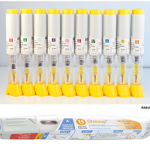Take the challenge. CPT: 20611-LT, J7325 X 1 ICD-9: 715.16—Osteoarthritis, localized, primary, lower leg ICD-10: M17.12—Unilateral pri- mary osteoarthritis, left knee Note: When billing for 20611—Arthrocentesis, aspiration and/or injection, major joint or bursa (e.g., shoulder, hip, knee, subacromial bursa), with permanent recording and reporting, there must be a permanent photograph of the needle placement in…
Rheumatology Coding Corner Question: Coding for a Knee Injection
Coding for a Knee Injection A 68-year-old female patient with primary osteoarthritis of the left knee returns to the office for her scheduled hyaluronan injection. The patient reports that her knee is a little tender, but on a scale of 1–10, it is a 4. She is stiff in the morning for 10–20 minutes. The…

Survey: Patient-Doctor Relationship Can Positively Affect RA Management
A new survey of more than 3,600 adults living with rheumatoid arthritis (RA) shows that a patient’s perception of their disease and treatment, as well as their relationship with their healthcare professional, can positively impact the management of their disease. The RA NarRAtive survey, created and sponsored by Pfizer, is part of an international initiative…

Dual-Trained Rheumatologists Take Multidisciplinary Approach to Their Patients
Co-morbidities in patients with rheumatoid arthritis and related autoimmune diseases often warrant a multidisciplinary approach to treatment. When it comes to inflammatory and fibrotic lung conditions in these patients, collaboration between pulmonary/critical care specialists and rheumatologists is essential, say two rheumatologists recently interviewed by The Rheumatologist. Both followed their rheumatology fellowship training with additional fellowships…

Exercise Guidelines for Fibromyalgia Patients
Fibromyalgia syndrome (FMS) is a condition characterized by widespread pain, abnormal pain processing, sleep disturbance and fatigue. It is commonly associated with psychological distress and co-morbid conditions. Impaired cognition is common in individuals with FMS, and is often referred to as fibrofog.1 According to the U.S. Centers for Disease Control and Prevention, the prevalence of…

Auto-Injectable Methotrexate: New Treatment Option for RA
Methotrexate has long been a cornerstone of therapy in rheumatoid arthritis. Two new, injectable methotrexate products may help some RA patients for whom oral methotrexate is not as effective or causes adverse effects. Rasuvo and Otrexup are prefilled, auto-injection devices that allow patients to give themselves subcutaneous injections of methotrexate without having to use a…

FOCIS 2015: Research Increases Understanding of Lupus, RA
The field of rheumatology took center stage when a handful of speakers discussed trends and research during a disease-oriented session of the 2015 Federation of Clinical Immunity Societies (FOCIS 2015) conference held in San Diego in June. Neutrophils in SLE Mariana Kaplan, MD, chief of Systemic Autoimmunity Branch at the National Institute of Arthritis and…

FOCIS 2015: TET Protein Regulation May Provide Insights for Cancer Treatment
A presentation given during FOCIS 2015, the 15th annual meeting of the Federation of Clinical Immunity Societies in June 2015 in San Diego, focused on advances in stem cell research related to treatment of cancer and the function that particular enzymes play in disease. Anjana Rao, PhD, professor at the La Jolla Institute for Allergy…

Vitamin D in Rheumatology: Cause and Effect Unclear
The controversy over vitamin D is hearty enough to confuse even seasoned rheumatologists, says Nathan Wei, MD, The Arthritis Treatment Center, Frederick, Md. “It’s like what you hear with coffee. One week, [a study finds] coffee is … good for you; the next week, there’s a study saying it’s bad for you,” he says. Vitamin…

Cardiovascular Risk in Tocilizumab Therapy for RA
Observation and research have confirmed that patients with rheumatoid arthritis (RA) are at greater risk of cardiovascular disease than their peers of similar age and gender, and that traditional risk factors and chronic inflammation associated with RA apparently play a significant role in that risk. However, predicting which patients with rheumatoid arthritis are at greater…
- « Previous Page
- 1
- …
- 17
- 18
- 19
- 20
- 21
- …
- 41
- Next Page »